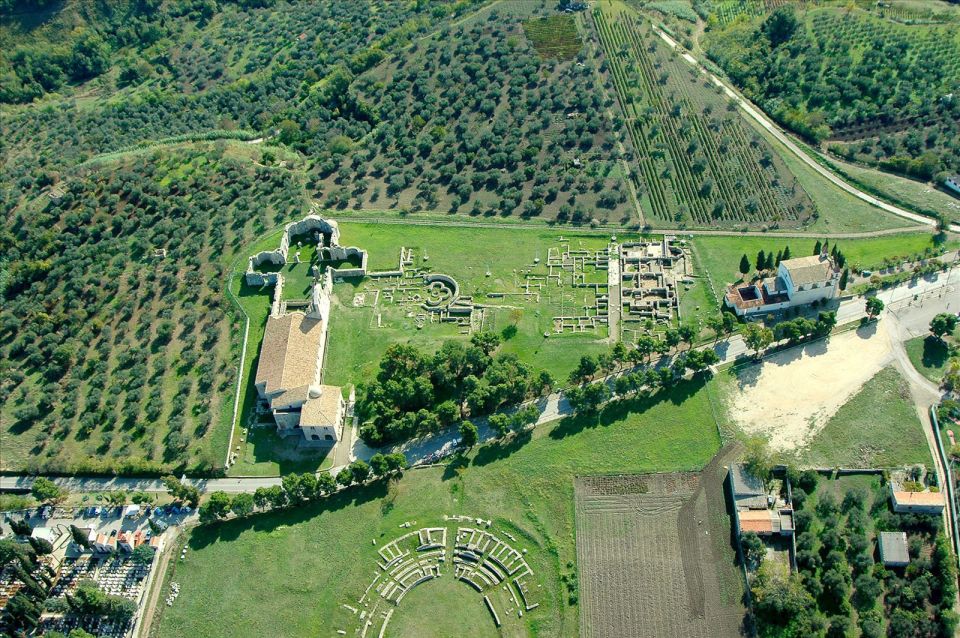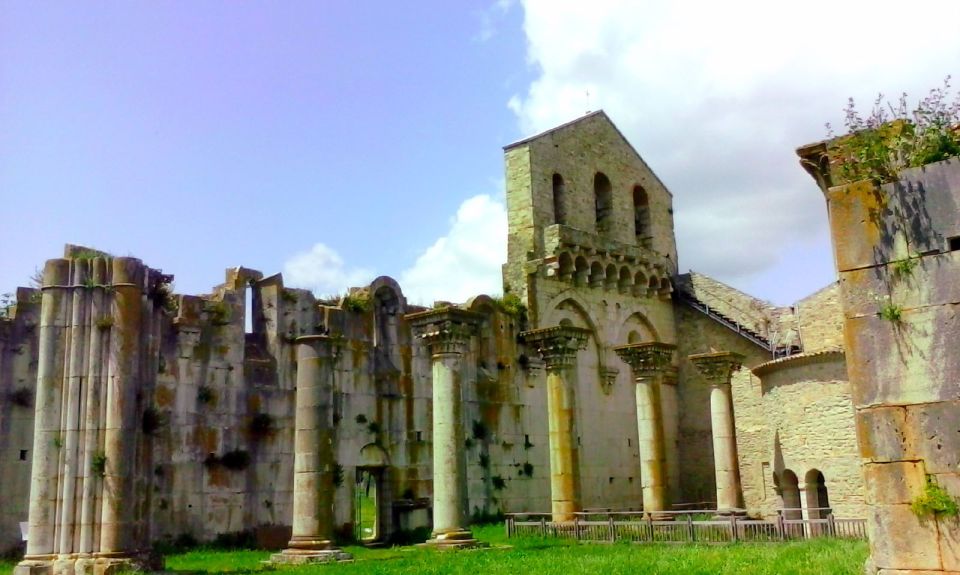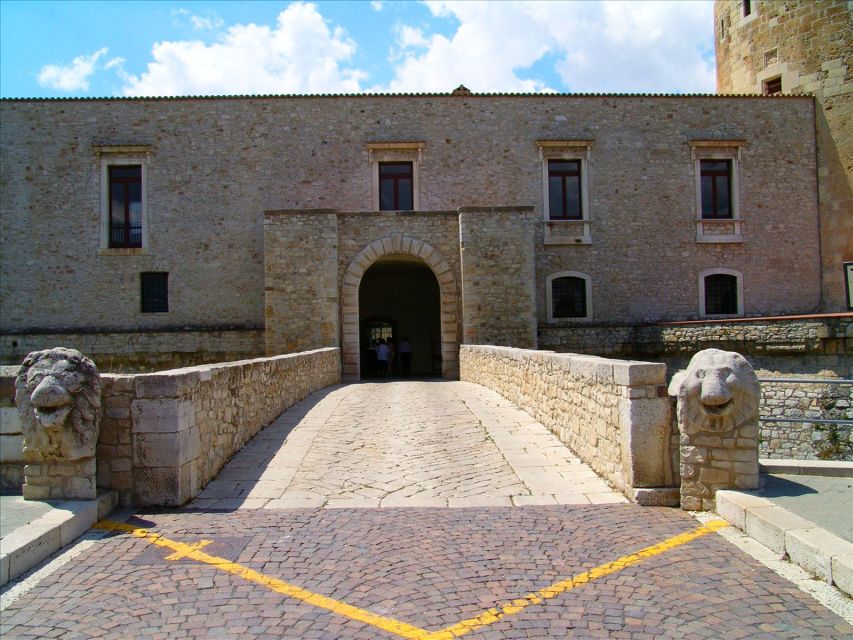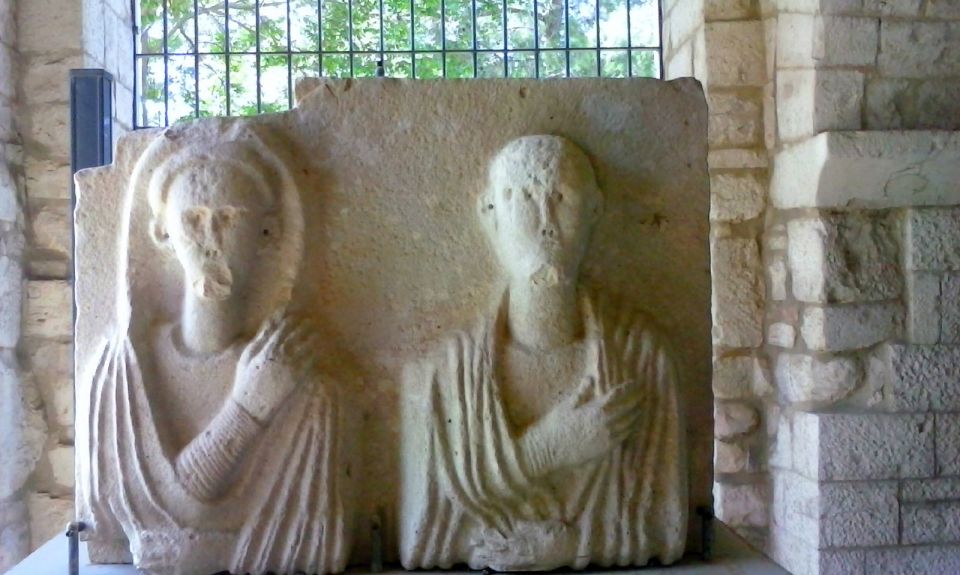Venosa, an ancient Roman town located near the picturesque city of Matera, offers visitors a captivating glimpse into Italy’s storied past. This well-preserved archaeological site boasts an array of remarkable structures, from the remnants of a 2nd-century BC amphitheater to the mosaic-adorned thermal baths. Exploring Venosa’s treasures, one can’t help but wonder about the lives of its elite Roman citizens, whose daily activities are preserved in the ‘House of Horace.’ With an Aragonese castle and a national archaeological museum housing Roman antiquities, this tour promises to transport you back in time and leave you eager to uncover more of Venosa’s secrets.
Key Points

- The guided Venosa tour explores an ancient Roman town, showcasing its well-preserved archaeological park with thermal baths, domes, amphitheater, and a 5th-century church.
- The unfinished 12th-century church in Venosa offers a glimpse into the architectural challenges faced by medieval builders in Basilicata.
- The 16th-century Aragonese castle in Venosa houses a national archaeological museum with a collection of Roman antiquities, including exquisite mosaics and stone carvings.
- The ‘House of Horace,’ a 2nd-century BC structure in Venosa, provides insight into the daily lives of the town’s elite Roman citizens.
- The Venosa tour provides a comprehensive experience of the town’s illustrious Roman history, with knowledgeable guides and well-preserved archaeological sites.
Tour Overview

The 2-hour guided tour of Venosa, an ancient Roman town in Basilicata, allows visitors to discover the archaeological park and unfinished church, as well as explore the Aragonese castle Pirro del Balzo and its national archaeological museum.
Highlights of the archaeological park include the thermal baths with mosaic-paved rooms, the two domes from the 2nd century BC, and the amphitheater and 5th-century church.
The unfinished church, started in the mid-1100s, was designed to hold a larger number of the faithful but was never completed.
The 16th-century Aragonese castle, with its four cylindrical towers and deep moat, houses a museum showcasing Roman antiquities, including the so-called ‘House of Horace.’
You can also read our reviews of more tours and experiences in Andria.
Archaeological Park Highlights

Situated within the archaeological park, the thermal baths boast a well-preserved frigidarium, tepidarium, and calidarium, their floors adorned with intricate mosaics. Nearby, two domes from the 2nd century BC stand as impressive remnants of the town’s advanced water system, used to collect and store rainwater. The park also features the remains of an ancient amphitheater and a 5th-century church, the SS. Trinity, which once stood alongside an abbatial palace.
| Thermal Baths | Domes | Amphitheater | Church |
|---|---|---|---|
| Frigidarium | 2nd century BC | Remains | SS. Trinity |
| Tepidarium | Rainwater collection | – | 5th century |
| Calidarium | – | – | Abbatial palace |
| Mosaics | – | – | – |
Unfinished Church Details

Designed to accommodate a larger congregation, the Unfinished Church in Venosa started construction in the mid-1100s but was never completed.
The grand ambitions of its builders were never fully realized, leaving the structure in a state of arrested development.
Despite its unfinished state, the church offers a fascinating glimpse into the architectural aspirations of medieval Basilicata.
Visitors can explore the scale and grandeur of the planned building, imagining how it might’ve looked had the project been finished.
The Unfinished Church stands as a testament to the challenges and complexities of large-scale construction in the Middle Ages, a silent monument to unfulfilled dreams and the passage of time.
Aragonese Castle Architecture
Within the historic town of Venosa stands the imposing Aragonese Castle, a 16th-century fortification featuring a distinctive square-plan design and four cylindrical towers.
Surrounded by a deep moat, the castle’s sturdy walls and towers provided formidable defenses against potential invaders.
Inside, visitors can explore the national archaeological museum, which houses a collection of Roman antiquities unearthed from the nearby archaeological park.
The castle’s unique architectural style is a testament to the region’s rich history and the strategic importance of Venosa during the Renaissance period.
Today, the Aragonese Castle remains a prominent landmark, offering visitors a glimpse into Venosa’s storied past.
More Great Tours NearbyNational Archaeological Museum
The national archaeological museum located within the Aragonese Castle houses an impressive collection of Roman antiquities unearthed from the nearby archaeological park, offering visitors a rundown of Venosa’s rich historical past.
Highlights include exquisite mosaics, intricate stone carvings, and an array of ancient artifacts that provide a fascinating glimpse into the daily lives of Venosa’s Roman inhabitants.
The museum’s well-curated exhibits guide visitors through Venosa’s evolution, from its founding as a Roman colony to its decline and eventual rediscovery.
With knowledgeable staff on hand to share insights, the museum adds depth and context to the archaeological site, making it a must-visit for anyone exploring the ancient wonders of Venosa.
House of Horace

Though referred to as the ‘House of Horace,’ this ancient structure actually dates back to the 2nd century BC, predating the famous Roman poet Horace who was born here in 65 BC. Archaeologists believe the home may have belonged to a wealthy merchant or local official, given its sizeable dimensions and intricate architectural features.
The house features several notable elements:
| Feature | Description | Significance |
|---|---|---|
| Mosaic Floors | Intricately patterned floors | Indicative of high-status occupants |
| Frescoed Walls | Vibrant wall paintings | Showcase of artistic skill and wealth |
| Hypocaust System | Underfloor heating | Advanced engineering for comfort |
This remarkably well-preserved Roman dwelling offers visitors a glimpse into the daily lives of the town’s elite citizens centuries ago.
Exploring Roman Venosa
Beyond the so-called ‘House of Horace,’ Venosa’s rich Roman heritage extends far deeper, offering visitors an immersive journey through the town’s illustrious past.
The centerpiece of this experience is the impressive archaeological park, which showcases the remarkable architectural and engineering feats of the ancient Romans.
Within the park, travelers can explore:
- The well-preserved thermal baths, complete with mosaic-paved frigidarium, tepidarium, and calidarium.
- The twin domes from the 2nd century BC, used to collect rainwater for the town’s water supply.
- The impressive amphitheater and the 5th-century church of SS. Trinity, along with the adjacent abbatial palace.
This comprehensive Roman experience provides a captivating window into Venosa’s storied history.
Guided Tour Experience
A guided tour of Venosa promises an immersive experience, taking visitors on a journey through the town’s rich Roman heritage.
Over the course of 2 hours, a local expert will lead the way, unveiling the archaeological park’s well-preserved thermal baths, amphitheater, and 5th-century church.
Highlights include the unfinished church, designed to accommodate more worshippers, and the Aragonese castle which now houses a national archaeological museum showcasing Roman artifacts.
Visitors will also get a glimpse of the so-called ‘House of Horace,’ where the renowned poet was born in 65 BC.
With insightful commentary and a chance to explore these remarkable ancient sites, the Venosa tour offers a deep dive into the region’s captivating past.
Frequently Asked Questions
What Is the Best Time of Year to Visit Venosa?
The best time to visit Venosa is in the spring or fall when the weather is mild and pleasant. Summer can be hot, while winters may be cool and rainy, making outdoor exploration less enjoyable.
Are There Any Nearby Attractions Besides the Sites in Venosa?
Besides the sites in Venosa, visitors can explore the nearby medieval town of Melfi, home to a 12th-century Norman castle. There are also several picturesque villages and vineyards throughout the Basilicata region that offer opportunities for further cultural and culinary experiences.
Is the Guided Tour Available in Multiple Languages?
The guided tour of Venosa is available in multiple languages. Visitors can choose between English, Italian, and other languages to learn about the ancient Roman town’s archaeological park, unfinished church, and Aragonese castle.
Are There Any Dining or Accommodation Options Near the Tour Sites?
There are several dining and accommodation options near the tour sites in Venosa. Visitors can find local restaurants, cafes, and hotels within a short distance of the archaeological park, castle, and other attractions.
Can I Purchase Tickets for the Tour Online in Advance?
Yes, tickets for the Venosa tour can be purchased online in advance. This helps ensure availability and allows visitors to skip the line at the tour sites. Online booking is the recommended way to secure your spot on the guided tour.
Recap
Venosa’s archaeological sites offer a captivating glimpse into ancient Roman life.
From the well-preserved thermal baths and Roman amphitheater to the National Archaeological Museum‘s Roman antiquities, visitors can explore the town’s rich history.
Don’t miss the ‘House of Horace,’ a 2nd-century BC structure that provides a unique look into the daily lives of Venosa’s elite.
A guided tour is the best way to fully experience this fascinating Roman destination near Matera.
You can check availability for your dates here:More Tours in Andria
- Organized tour from Bari to Castel del Monte
- Olive Grove Walking, Puglian Food and Olive Oil Pairing Tour
- Full Tour: Lets Discover How to Make Olive Oil Tour
- Golf Cart Tour and Aperitif in the Ancient Masseria
- Olive Oil Tasting and Olive Grove Walking Tour
- Andria: Castel Del Monte Private Historical Tour
